Kumari: The Living Goddess Of Nepal
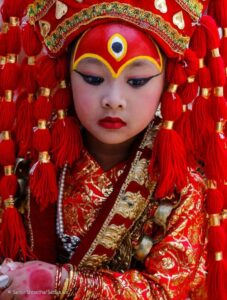 Nestled in the lap of the Himalayas, Nepal is a land of breathtaking landscapes, ancient temples, and a deep spiritual legacy. One of the most captivating and mysterious aspects of Nepal’s rich culture is the tradition of the Kumari, a living goddess revered by both Hindus and Buddhists. The Kumari is not just a symbol; she is a living, breathing embodiment of divinity, and her presence in Kathmandu’s Durbar Square is a source of wonder and fascination for visitors and locals alike.
Nestled in the lap of the Himalayas, Nepal is a land of breathtaking landscapes, ancient temples, and a deep spiritual legacy. One of the most captivating and mysterious aspects of Nepal’s rich culture is the tradition of the Kumari, a living goddess revered by both Hindus and Buddhists. The Kumari is not just a symbol; she is a living, breathing embodiment of divinity, and her presence in Kathmandu’s Durbar Square is a source of wonder and fascination for visitors and locals alike.
The Kumari tradition is a fascinating glimpse into the harmonious coexistence of religious beliefs, history, and the living culture of Nepal. As we embark on this journey to uncover the layers of this unique practice, we will delve into its history, the elaborate selection process, the roles and responsibilities of the Kumari, and its cultural significance. This sacred tradition offers a window into the mystical world of Nepal, where the boundaries between the mortal and the divine blur, and the past and present coalesce into a timeless tapestry of spiritual devotion and cultural heritage.
The Historical Origins of Kumari Tradition
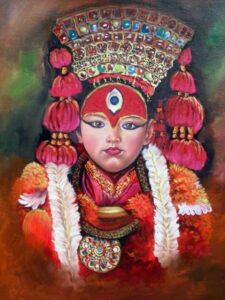
The Kumari tradition has deep historical roots that trace back to the Kathmandu Valley, the cultural heart of Nepal. It is said to have emerged during the Malla dynasty rule in the 17th century when Kathmandu was divided into three separate kingdoms: Kathmandu, Patan, and Bhaktapur. This tradition is a unique blend of Hinduism and Buddhism, the two predominant religions in Nepal. In Hinduism, the Kumari embodies the concept of the living goddess, representing divine femininity. In Buddhism, the Kumari is seen as the earthly incarnation of the goddess Taleju, who was originally a revered deity in the Newar community. This syncretism of beliefs reflects the harmonious coexistence of different religious influences in Nepal.
The goddess Taleju, believed to be an incarnation of the Hindu goddess Durga, was highly revered in the Kathmandu Valley. She was considered the guardian deity of the Malla kings, and her worship was an integral part of their rule. The connection between Taleju and the royal family became significant in the Kumari tradition. Originally, the Kumari was selected from young girls of the Shakya caste, traditionally considered the Buddha’s clan. The transition from a revered deity to a living child underscores the significance of purity and divinity in the selection process.
The Rajput tradition, which originated in India, also played a role in shaping the Kumari tradition. The Malla kings, who ruled the Kathmandu Valley, sought to establish their divine right to rule, similar to the Rajput tradition where kings were seen as the earthly representatives of gods. Selecting a Kumari was a means to strengthen their claim to divine authority.
Selection Process:
The selection of the Kumari is a rigorous and intricate process. Candidates must meet specific criteria: they should be young, prepubescent girls from the Newar community of Kathmandu, displaying specific attributes. The selected girl should possess specific physical attributes, such as unblemished skin, hair, and eyes, with no visible scars or physical imperfections. Additionally, her body proportions are closely examined. Additionally, she should come from a family with good karma and have no traces of defilement or impurity, such as menstrual blood. After meeting these prerequisites, a Kumari is selected from a pool of eligible candidates.
The candidates are observed and tested for their ability to remain calm, composed, and fearless during various rituals and ceremonies. This is a crucial aspect of the selection process as it reflects the Kumari’s ability to handle the intense and often overwhelming public appearances that she will make in her role.
The astrological charts of the candidates are analyzed to ensure their compatibility with the Kumari tradition. The selected Kumari must have a favorable astrological alignment, ensuring her well-being and the well-being of the people she represents. One of the final stages of the selection process involves the candidate being taken to the Taleju Temple, where she must correctly identify various objects that belonged to the previous Kumari. It is believed that the goddess Taleju herself, through the possession of the current Kumari, plays a role in the selection.
Once the Kumari is selected, she undergoes an intense period of isolation, during which she is removed from her family and placed in the Kumari Ghar (Kumari’s residence) in Kathmandu Durbar Square. Here, she receives training in traditional dances, religious rituals, and customs. She also learns to communicate through symbolic gestures and expressions, as her role often involves maintaining silence during public appearances. The final selection is announced to the public in a grand ceremony, marking the official start of the Kumari’s tenure as a living goddess. She is dressed in traditional attire and adorned with intricate makeup and jewelry.
Roles and Responsibilities:
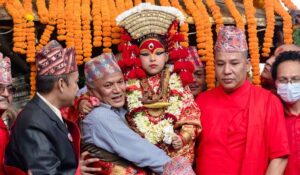
Kumari, The Living Goddess of Nepal in Indra Jatra Festival.
Once selected, the Kumari lives in the Kumari Ghar, a palace in Kathmandu Durbar Square. She plays a crucial role in the religious and cultural life of Nepal. The Kumari makes occasional public appearances during religious festivals, wearing traditional attire and adorned with intricate makeup and jewelry. Her presence is believed to bring blessings, protection, and good fortune to those who catch a glimpse of her. It is said that she can foretell the future and provide guidance to those who seek her audience. People from Nepal and around the world visit the Kumari’s residence, Kumari Ghar, to seek her audience. Devotees come with offerings and prayers, hoping to receive her blessings and guidance. The Kumari is expected to maintain silence during her public appearances. She communicates through symbolic gestures and expressions rather than speaking.
Retirement:
The life of a Kumari is temporary, and her status as a living goddess ends when she reaches puberty, as she is no longer considered pure. Upon retirement, she is expected to return to a normal life and is provided with financial support from the state. The transition to a regular life can be challenging for former Kumaris, as they have spent their formative years in a highly sheltered and sacred environment. The most fundamental reason for the retirement of the Kumari is the onset of puberty. In Nepalese culture, puberty is considered a phase of life that represents the loss of purity and innocence. As the Kumari is selected for her prepubescent purity, the arrival of menstruation signifies a transition into womanhood and is seen as incompatible with her role as a living goddess. The Kumari is expected to maintain the utmost purity throughout her tenure. As menstruation is considered a natural bodily function, it is perceived as detracting from the required purity and sanctity of the living goddess.
Cultural Significance:
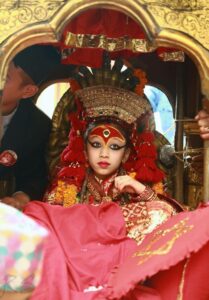
The Kumari represents the divine feminine energy, embodying the qualities of purity, grace, and power. She is revered as a living goddess, making her a symbol of the divine presence in daily life. This tradition is a unique blend of both Hinduism and Buddhism, two major religions in Nepal. This harmonious coexistence of religious influences showcases Nepal’s cultural diversity and tolerance. It has its roots in the Malla dynasty of the 17th century, and it is deeply connected to the history of the Kathmandu Valley. It serves as a living link to the region’s ancient past.
The Kumari tradition is historically linked to royalty, with the goddess Taleju being a guardian deity of the Malla kings. It reflects the idea of the divine right to rule and the monarch’s connection to the divine. It attracts tourists from around the world, contributing to Nepal’s tourism industry. It also fosters international interest and curiosity in the country’s unique customs and traditions.
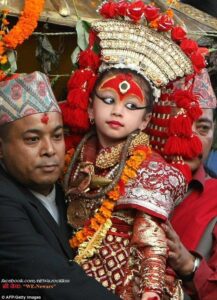
Kumari is a unifying symbol in Nepal, as people from diverse backgrounds and religious beliefs come together to celebrate her during festivals and public appearances. Her role transcends religious and cultural boundaries.
The Kumari tradition in Nepal is a remarkable testament to the nation’s spiritual and cultural richness. It continues to intrigue and captivate people from all around the world. As visitors to Nepal, respecting and understanding the sacred nature of this tradition is of utmost importance. The Kumari is not just a living goddess but a living embodiment of Nepal’s heritage, and her presence symbolizes the enduring connection between the divine and the earthly in this beautiful Himalayan nation.
In conclusion, while the Kumari tradition in Nepal is undeniably steeped in cultural and spiritual significance, it is not exempt from scrutiny and criticism. The tradition’s shortcomings become apparent as one examines the potential loss of childhood, limited education, and isolation experienced by Kumari candidates, who are thrust into a life of strict rituals and public expectations from a very young age. The retirement of the Kumari, although a significant rite of passage, can also pose challenges as the girls transition to a normal life. Furthermore, concerns are raised about the potential psychological impact of their roles, and the limited say they have in their destiny as living goddesses. As Nepal modernizes, there is an ongoing debate about striking a balance between cultural preservation and the well-being and rights of the individuals involved. It’s essential to approach the Kumari tradition with a nuanced understanding, acknowledging both its cultural richness and the need for protecting the rights and welfare of the young girls who become Kumaris. This complexity serves as a reminder of the ever-evolving relationship between tradition and the changing cultural landscape of Nepal.
